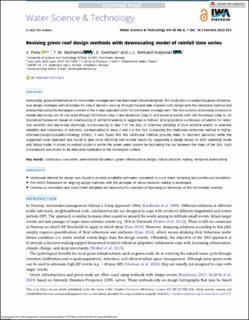Revising Green roof design methods with downscaling model of rainfall time series
Peer reviewed, Journal article
Published version
Permanent lenke
https://hdl.handle.net/11250/2982898Utgivelsesdato
2022Metadata
Vis full innførselSamlinger
- Publikasjoner fra CRIStin - SINTEF AS [5802]
- SINTEF Community [2248]
Originalversjon
10.2166/wst.2022.023Sammendrag
Historically, green infrastructure for stormwater management has been event-based designed. This study aims to realign the green infrastructure design strategies with principles for robust decision making, through the example of green roofs design with the variational method and exemplified using the Norwegian context of the 3-step approach (3SA) for stormwater management. The 3SA consists of planning solutions to handle day-to-day rain at site scale through infiltration (step 1) and detention (step 2), and extreme events with safe floodways (step 3). An innovative framework based on downscaling of rainfall timeseries is suggested as follows: (i) long duration continuous simulation for retention variation and day-to-day discharge, corresponding to step 1 in the 3SA; (ii) intensive sampling of local extreme events to estimate reliability and robustness of solutions, corresponding to steps 2 and 3 in the 3SA. Comparing the traditional variational method to Highly-Informed-Design-Evaluation-Strategy (HIDES), it was found that the variational method possibly leads to incorrect decisions while the suggested novel approach was found to give more informed and reliable results by suggesting a design based on both operating mode and failure mode. It allows to embed solutions within the urban water system by facilitating the link between the steps of the 3SA. Such a framework was found to be data-wise applicable in the Norwegian context.

